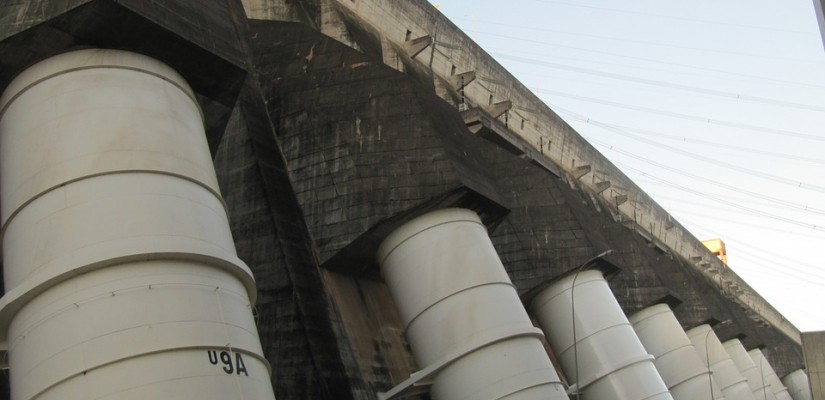Itaipu dam at the border between Brazil and Paraguay is a marvel in terms of its electric output and a sore spot in terms of its political significance for Paraguay. The construction of the dam was agreed upon by Brazil’s and Paraguay’s heads of state, Emilio Garrastazu Medici and Alfredo Stroessner, in 1973 and completed in 1991. Ever since, the mega dam produces the largest amount of hydropower-sourced electricity in the world alongside the newer Three Gorges dam in China, reaching roughly 100 megawatt hours (MWh) per year. The bilateral agreement between Brazil and Paraguay itself, however, is a point of contention for many Paraguayans who regard the treaty as more favorable to Brazil than Paraguay. In July 2019, the disclosure of a secret deal regarding Itaipu dam between Paraguay’s incumbent president, Mario Abdo Benitez, and Brazil’s incumbent president, Jair Bolsonaro, from May 2019 caused an uproar among Paraguay’s citizens, who demanded the impeachment of their president. The deal would have put Paraguay in a financially disadvantaged position, but it was eventually discarded due to the resistance from the public.
Settling border conflicts between Brazil and Paraguay, the two countries signed the Itaipu dam treaty in 1973 and founded the umbrella company Itaipu Binacional a year later, under which the two states operate. Brazil’s largest electric utility company, Eletrobras, contributed the largest loan to build the dam. The agreement stipulates that both countries have a right to half of the dam’s energy output. Furthermore, any energy surplus that is not consumed by either of the two countries must be sold to the other country, leaving Brazil and Paraguay as the only consumers of the electricity generated at Itaipu dam. The price of these interstate sales, however, is not based on the regional market price for energy but the cost of production.
These terms put Paraguay at a disadvantage because, firstly, Paraguay consumes so little energy that it must sell most of its share to Brazil, and secondly, sales to Brazil at the production price instead of the market price resulted in a loss of USD 75.4 billion in revenue for Paraguay between 1985 and 2018, according to a study by Miguel Carter of the Paraguayan think tank Demos. Paraguay has a population of nearly 7 million while Brazil has 120 million inhabitants. Therefore, it is not surprising that Paraguay’s energy demand is much lower than Brazil’s. Paraguay only requires roughly 15% of the energy produced at Itaipu dam and sells the remaining 85% to Brazil, whereas Brazil covers only about 15% of its domestic energy demand with the hydroenergy from Itaipu dam. In 2009, another deal on Itaipu dam was struck between the two countries. According to this addendum, Brazil promised to triple its annual payments to Paraguay to USD 360 million. The deal of May 2019, however, would have decreased Brazil’s payments to Paraguay by 18% over the following three years.

Another sore point for Paraguay is the domestic control of its top export product, soybeans, by brasiguayos, Brazilians settled in Paraguay. Almost all of the country’s soybean reserves are produced by brasiguayos, who were allowed to buy land in eastern Paraguay and developed the agricultural sector since the 1960s and 1970s as part of the country’s binational development plan. As the world’s fourth largest soy exporter, Paraguay’s economy is now driven by its agricultural sector. Thus, Brazilian control of the two vital natural resources, soy and hydropower, remains a controversial issue, illustrating Paraguay’s weak sovereignty in relation to its neighbor Brazil.
While Paraguay is among the poorest countries in South America, its economic profile has improved significantly since the early 2000s, granting the country a relatively positive future outlook. The country’s average economic growth was 4.5% in the course of the last 15 years and its GDP has risen from approximately USD 7 billion in 2003 to USD 40 billion in 2019. At the same time, Paraguay’s poverty rate has fallen, the middle class has grown substantially, and the per capita GDP has increased. While the government struggles to implement fiscal reforms against the backdrop of resistance from local farming businesses, the economy has stayed relatively stable while other countries like Brazil and Argentina experienced recessions. Furthermore, domestic electricity costs are low due to the immense energy output of Itaipu dam. This factor, as well as low tax and cheap labor, have made the country attractive to foreign direct investment, which has increased from USD 1 billion to USD 6 billion between 2003 and 2017.
The year 2023 will constitute a signpost for Paraguay’s economic future and the strength of its sovereignty as the 50-year-old Itaipu agreement will expire and the two countries are preparing for renegotiations. Depending on the outcome of the 2023 negotiation, a future treaty can be a risk to Paraguay’s development or an opportunity to diversify its economy. Paraguay would profit if it could sell excess hydroenergy to third parties instead of Brazil. Areas that would benefit from greater investment are infrastructure, education, and healthcare. As industrialization in Paraguay gradually advances, the country will also require larger amounts of energy for itself. Therefore, the country must anticipate that the hydroenergy surplus gap will likely shrink. Finally, a major challenge that Paraguay must overcome is brokering more favorable terms in a renewed treaty with Brazil and making efficient use of its young workforce and enormous energy supply.
